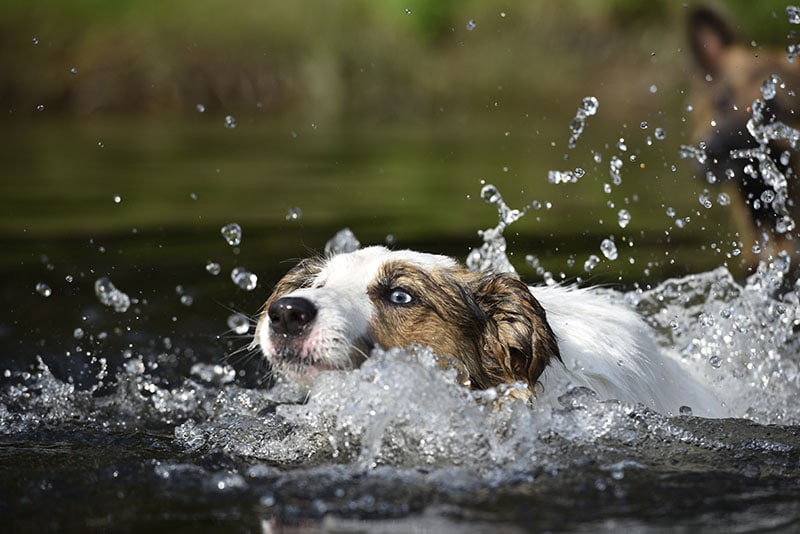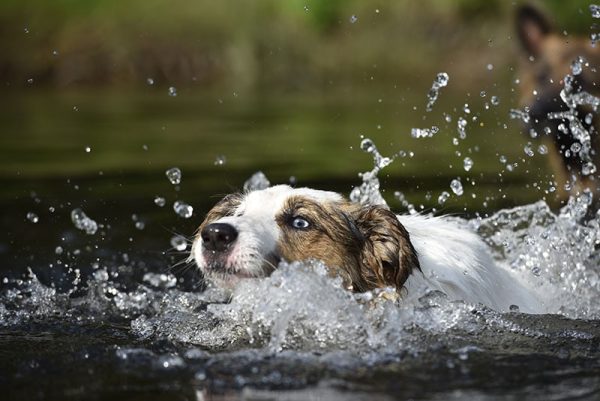Click to Skip Ahead
Dogs use a number of methods to communicate with each other and with us. Body language is an important means of communication, with the tail being one of the quickest ways for us to tell how our dogs are feeling. But what exactly does it mean when your dog isn’t able to wag their tail or really move it at all?
Swimmer’s tail is a painful condition that temporarily affects the dog’s ability to use their tail. In this article, we’ll discuss the signs and cause of swimmer’s tail as well as the treatment.

What Is Swimmer’s Tail?
First of all, the clinical term for swimmer’s tail is acute caudal myopathy, but it also goes by quite a number of other names.
- Limber tail
- Dead tail
- Cold water tail
- Limp tail
- Broken tail
- Rudder tail
- Broken wag
Although some of the names it’s known by call it broken, swimmer’s tail is NOT a broken tail!
It tends to come on without any warning and can appear as though the tail is broken, which is where some of those names come from. It has often been called swimmer’s tail because it can occur after the affected dog has been swimming.

What Are the Signs of Swimmer’s Tail?
- Limp tail from the base to the tip
- Limp tail held horizontally from the base about 3–4 inches, and the rest is limp
- No tail movement, including no wagging
- Signs of pain and discomfort
- Reluctance to sit due to tail pain
- Reluctance to defecate due to pain from squatting
- Whining and whimpering
- Lethargy
- Licking and chewing the tail
- Loss of appetite
- Minor loss of balance
- Raised hair along the base of the tail
The primary signs are the drooping tail and obvious pain, particularly if you touch the tail.

What Are the Causes of Swimmer’s Tail?
Typically, swimmer’s tail occurs following the overuse of the tail, which is thought to cause a strain or sprain of the muscles used for tail wagging.
- Very vigorous play with excess tail wagging
- Extended time swimming
- Long periods of hunting
- Strenuous workouts, particularly with unfit dogs
- Prolonged time in a cage for transport
- Extended periods of time in the water too cold or too warm
The most common cause seems to be overexertion in very cold water or weather. In fact, it was found that dogs that live in northern areas are more likely to suffer from swimmer’s tail. And with every degree of latitude (one degree of latitude is about 69 miles or 111 km), the chances increase by almost 50 percent.
It’s far more common in hunting dogs, particularly Pointers and Retrievers. The signs don’t always occur directly after exertion and can actually take a few hours or even days to appear.

How Do I Care for a Dog With Swimmer’s Tail?
The treatment for swimmer’s tail takes place at home for the most part, but it’s best to bring your dog to your veterinarian to ensure it isn’t another issue.
Your veterinarian will perform an examination and might take X-rays to ensure there isn’t something such as a fracture.
If it’s causing your dog a lot of pain, your vet might prescribe an anti-inflammatory or muscle-relaxer to help with the pain. Ensure your dog avoids overexcitement. That tail needs to rest! If all goes well, most dogs are back to their normal selves in just a few days or up to a week.

Frequently Asked Questions
Are there any other conditions that present as swimmer’s tail but are another issue?
We mentioned earlier that the vet will check your dog’s tail for a fracture, which is a condition that might be mistaken for swimmer’s tail.
- Inflammation or infection of the anal glands
- Lower back pain from osteoarthritisor intervertebral disc disease
- Prostate disease
- Trauma to the tail
- Cauda equina syndrome
This is why bringing your dog to your veterinarian is so important when they are experiencing pain around the lower back and tail. Many of these conditions are quite serious and need treatment by your vet, so it’s better to bring your dog in to receive the proper diagnosis.
Are there specific dog breeds prone to swimmer’s tail?
The breeds that are more susceptible to it are:
- Retrievers: Golden Retrievers, Labrador Retrievers, and Flat-Coated Retrievers
- Pointers: English Pointers
- Hounds: Foxhounds, Coonhounds, and Beagles
- Setters: English Setters
Young male working and hunting dogs are the most susceptible, but any dog is vulnerable to swimmer’s tail.

How can you prevent swimmer’s tail from occurring?
If your dog has had swimmer’s tail previously and if they are one of the high-risk working breeds, you’ll need to take extra care.
You don’t want to make a sudden change to your dog’s activity level. For example, if your dog spends most days at home and going for daily walks, don’t suddenly jump into intensive exercise – it should be a gradual change.
Cold weather and water are also definite factors to look out for. If it’s frigid outside and your dog is going to be active, put them in a doggie coat. Also, allow them breaks in between working and start them off with shorter training sessions before a day full of activity.
Finally, if your dog is confined to a crate during hunting or competition events, let them out for frequent stretching. And ensure the crate is large enough that they can lie down without their tail becoming compressed since this is also a frequent cause.
Conclusion
Swimmer’s tail is not a pleasant experience for any dog. If your dog seems to not be using their tail and it’s hanging limply, there is a chance that it’s limber tail, also known as swimmer’s tail. It’s essential to see your vet not only so it can be appropriately treated but to ensure it’s not something else that’s more serious.
But the good news is that swimmer’s tail is easily treated and will clear up in about a week. And don’t stop your dog from participating in swimming or other favorite activities out of fear of swimmer’s tail. Just as long as you keep the risk factors we discussed in mind, your dog can wag that tail as much as they want!
Featured Image Credit: TamaraLSanchez, Shutterstock










